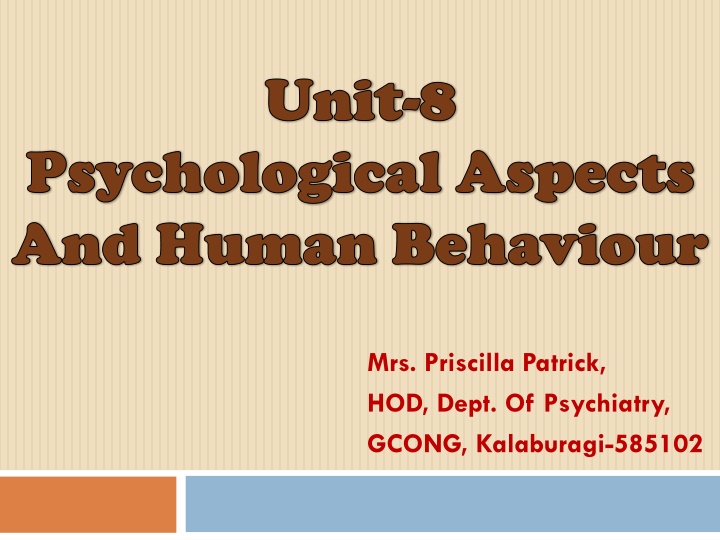
Human Behavior and Psychological Aspects Explored
Delve into the intriguing world of human behavior and psychological aspects with insights on social norms, genetic influences, brain functions, and more. Explore the definition, factors, and basic terminologies related to human behavior, all presented in an engaging manner by Mrs. Priscilla Patrick, HOD of Psychiatry at GCONG, Kalaburagi-585102.
Download Presentation

Please find below an Image/Link to download the presentation.
The content on the website is provided AS IS for your information and personal use only. It may not be sold, licensed, or shared on other websites without obtaining consent from the author. If you encounter any issues during the download, it is possible that the publisher has removed the file from their server.
You are allowed to download the files provided on this website for personal or commercial use, subject to the condition that they are used lawfully. All files are the property of their respective owners.
The content on the website is provided AS IS for your information and personal use only. It may not be sold, licensed, or shared on other websites without obtaining consent from the author.
E N D
Presentation Transcript
Unit Unit- -8 8 Psychological Aspects Psychological Aspects And Human Behaviour And Human Behaviour Mrs. Priscilla Patrick, HOD, Dept. Of Psychiatry, GCONG, Kalaburagi-585102
1. Psychological Aspects, Human Behaviour And Defense Mechanism 2. Life Process, Growth And Development 3. Communication And Inter Personal Relationships 4. Coping With Loss, Death And Grieving 5. Stress Adaptation 6. Principles And Techniques Of Counselling
Introduction The behavior of people falls within a range with some behavior being common, some unusual, some acceptable, and some outside acceptable limits. In sociology, behavior is considered as having no meaning, being not directed at other people and thus is the most basic human action. Behavior should not be mistaken with social behavior, which is more advanced action, as social behavior is behavior specifically directed at other people. The acceptability of behavior is evaluated relative to social norms and regulated by various means of social control.
Definition Human behavior is the population of behaviors exhibited by humans and influenced by culture, attitudes, emotions, values, ethics, authority, rapport, hypnosis, persuasion, coercion and/or genetics. FACTORS AFFECTING HUMAN BEHAVIOUR Genetics Attitude Social Norms Perceived Behavioral Control
Basic Terminologies Assertive Assertive : Confident, decisive, positive, strong willed Avoidance Avoidance : Aggressive Aggressive : Offensive, hostile, violent, warlike Accommodative/Submissive ccommodative/Submissive : Unassertive, unresisting, and obedient. Biology Biology Psychology Psychology Behavior Behavior
The Brain And Behaviour Our brain is considered as most complex organ and centre-piece of nervous system. Brain is a physical organ like muscles and bone Our brain is divided into three interconnected layers central core, limbic system and cerebral cortex, which regulate the everyday's activities. The brain is unique and it is psychological organ.
BRAIN A PSYCHOLOGICAL ORGAN The brain is unique and is psychological organ, ultimately responsible for our moods of despair and elation, our sense of wellbeing and our sensation, perception of outside world and our awareness of its meaning. We must trace, if we have to gain a meaningful understanding of our personality and why we behave as we do.
STRUCTURE OF NEURON [BASIC UNIT OFNERVOUS SYSTEM]
Brain is the psychological organ. It gives rise to the mind that is to mental processes (such as perception, memory and language) and mental experiences. All the brain activities are carried by neurons or brain cells. There are three types of neurons:- 1.Sensory neurons: respond to input from senses 2.Motor neurons: send signals to muscles to control movements 3.Interneuron: stands between the neurons that register what's out there and those that control movements.
Each Neuron has Certain Parts The central part of a neuron is called the cell body regulates cells function and a cell membrane sending end of neuron is the axon cell's body, along which signals travel to other neurons, muscles or bodily organs. Each neuron has only a single axon. Most axons have many branches called terminals terminals, so that a neuron can send a message to more than one place at a time. At the ends of the terminals are terminal buttons terminal buttons, little knob like structures that release chemicals into space between neurons when neurons have been triggered. Most of neurons communicate by releasing chemicals called neurotransmitters that affect other neurons, usually at their receiving end. Each neuron has only one sending end that only has one axon, but having many receiving ends called dendrites dendrites. Dendrites receive messages from the axons of other neurons. cell body. It has a nucleus cell membrane, which is the skin of the cell. The axon, the long cable like structure extending from nucleus, which neurotransmitters
Functions Of A Neuron
1. Action Potential Neurons at rest have to maintain negative charge within them called resting potential. During rest, more positively charged ions called cations and sodium ion are outside than inside and more negatively charged are inside the neurons, membranes covering the axon have very small holes or pores called channels, which open and close. When neuron receives enough stimulation from other neurons, some of channels open, allowing exchange of ions that changes charge in the axon. This exchange moves down towards terminal buttons.
When a neuron is resting and not conducting a nerve impulse, the inside of cell has negative charge. A stimulus which excites the cell will make the inside charge a little less negative. At rest, sodium ions cannot enter because even though the cell membrane is permeable, the openings are too small at this time for big sodium ions to enter. When cell receives strong stimulation from other cell, the cell membranes open up the special gates, one after the other, allowing the sodium ions to rush into cell. this causes inside the cell, positive and outside of the cell to become negative. This electrical reversal change is called action potential. It takes 1 of 1000th second, so the neural message travels very fast from 2 miles per hour in the slowest and 270 miles per hour in other neurons. This action potential travelling down the axon. After the action potential passes, the cell membrane pumps out the sodium ions back outside the cell and closing the gates until next action potential comes.
2. Synapse And Their Functions The ends of axons actually reach out several branches called axon terminals. The tip of each terminal has a little knob called synaptic knob or terminal buttons. It has a number of little sac-like structures called synaptic vesicles. Inside the synaptic vesicles, are the chemicals suspended in fluid called neurotransmitters. Between terminal buttons and dendrites of another neuron, there is fluid filled space called synapse or synaptic gap. Synaptic vesicles contain neurotransmitter molecules whereas dendrites of next neuron contain receptor sites. They have particular shape that allows only a particular neurotransmitter to fit into it. When electrical charge reaches the synaptic vesicles, they release their neurotransmitters into the synaptic gap. Molecules float and many fit into the receptor sites, activating the next cell.
3. Neurotransmitters Neurochemists and pharmacologists have identified a number of neurotransmitters at synapse. Acetylcholine: It is the neurotransmitter found at the synapse between neurons and muscle cells. If acetylcholine receptors sites on the muscle cells are blocked in some way, then muscle will be paralyzed or unable to contract. Gaba (g.aminobutyric acid): It is the common inhibitory neurotransmitter in the brain. GABA can help to calm anxiety. Serotonin: It is a neurotransmitter found in the lower part of the brain and it can act as an excittatry or inhibitory chemical depending upon its location in the area of brain. It is mainly associated with mood, sleep and appetite. Lower levels of serotonin are linked with depression.
Dopamine: It is found in the brain and has different effects depending upon its location. If too little dopamine is released in a certain area of brain, it results in Parkinson's disease and too much dopamine results in Schizophrenia. Endomorphins: These are the pain controlling chemicals in the body. When person is hurt, the neurotransmitters that signal pain, are released. When brain gets this message, it triggers the release of endomorphins. Endomorphins bind to receptors that open gates on next axon. This causes the cell to be unable to fire its signal, the pain sensation eventually subsides
4. Reuptake of Neurotransmitters One method of deactivation is by catalysts called enzymes, which triggers chemical reactions those breakup neurotransmitters molecules. Second method is by process of reuptake. In this process, terminal buttons take back the release neurotransmitters and store it in vesicles for use for next time. Drugs mainly psychoactive drugs may interfere with synaptic transmission
Function of Central Nervous System in Behavior The central nervous system is composed of the brain and spinal cord. Both brain and spinal cord are made of neurons and glial cells that control the life-sustaining functions of body as well as thought, emotions and behavior. The Brain The Brain Brain is the true core of nervous system, the part that takes information received from the senses, makes sense out of it, makes decisions and sends commands out to the muscles and the rest of the body.
5. Reflex Arch Inner section of spinal cord is made up of cell bodies separated by glial cells. This part is responsible for the certain reflexes-very fast and lifesaving reflexes. Mainly three types of neurons are responsible for reflex action sensory, motor and interneurons. These kind of response are controlled by spinal cord along for fast response.
The Spinal Cord The Spinal Cord It is a long bundle of neurons that serves two vital functions of the nervous system. To carry messages from body up to the brain, From the brain down to the body It is divided into two areas outer and inner. Outer region is composed mainly of axons and nerves, which appears white and inner section is mainly composed of cell bodies of neurons which appear grey.
Structure Of The Brain
Parts of the brain Brain Stem, Cerebellum and Reticular Formation (Central Core) Forebrain: Thalamus (Limbic System) Cerebral Cortex Frontal Area Personality and General Behavior Pattern Left hemisphere Right hemisphere
Brain Stem, Cerebellum and Reticular Formation (Central Core) Brain stem consists of four divisions: The medulla, the pons and the midbrain. These all help to control and regulate many bodily functions like breathing, temperature regulation, etc. which are necessary for life. Cerebellum is the brain's large, complex structure. It receives sensory and other inputs from spinal cord, brain stem and forebrain. It processes this information and then sends output to many parts of brain to help to make our movements precise, coordinated and smooth and also helps to control posture and maintains equilibrium.
Reticular formation is a complex region from medulla to the midbrain and contains many small clumps of neurons and a number of long and short nerve fibers. It helps in activation and arousal of the cerebral cortex and remains active during sleep. It is also helpful in various degrees of arousal from deep sleep state to alert awareness of the environment. If this region is destroyed, a deep sleep state may occur just like coma. Pons trigger dreaming and waking up from sleep. Medulla is a center of breathing, waking, sleeping and beating of heart.
Forebrain: Thalamus (Limbic System) Just above the midbrain, a kind of expanded bulb on top of the brain stem called thalamus. It lies between the two cerebral hemispheres and is covered by them. Their main function is to receive main inputs from other nuclei within itself and then send fibers to the cortex. This can also transform and modify input before sending it on the cerebral cortex.
Forebrain Hypothalamus and Pituitary Lying below the thalamus, there is a small but vital area of the forebrain known as hypothalamus. Its importance is that it contains nuclei which are related to motivated behavior. Functions Functions It receives reports about state of internal environment from the other bodily organs. When internal environment changes from their homeostatic level, certain hypothalamic neurons become active and send information to the pituitary gland. It monitors the blood glucose and salt level, blood pressure and hormones. Hypothalamus is also means of nerve impulses sent to pituitary or by chemicals called hormones or releasing factors. Sexual and maternal behavior and learning and memory are the important functions of pituitary gland.
Cerebral Cortex Forebrain Forebrain It weighs about 1400 gms and divided into two cerebral hemispheres and further into different lobes. These have an important role to play in regulation and control of movements. Various regions of cerebrum have different functions to movement of specific parts of body. It can control bodily movements and play an important role in the regulation and control of movement. Cerebral cortex has motor and sensory functions. Motor areas are concerned for bodily movements and other areas. Damage of these parts may result in partial paralysis or complete paralysis of the whole body.
Frontal Area Personality and General Behavior Pattern It assists in motor control and cognitive activities such as decision making, planning and setting goals. Two different types of personality changes follow prefrontal lobe damage. It includes lack of impulsiveness, immaturity in social relationship, and loss of initiative, decrease in spontaneous talking, reduced emotional expressions are main features. Intellectual changes include lack in direction of behavior, inflexibility and memory impairment, problems in planning, and remembering the order of recent events.
Temporal Lobe Association Cortex The temporal lobe of each hemisphere lies below the lateral fissure in cerebral cortex. Its main functions are hearing and language. Sensory Functions Sensory Functions It is involved in hearing, perception and recognition of sounds. Difficulty in recognizing problems or melodies may result from damage to temporal lobe association cortex. It helps in auditory perception and visual recognition. Damage also results in impaired sensation and trouble in indentifying pictures of common objects and recognizing facts. Language Functions Language Functions Left temporal lobe contains a region of association cortex called Wernicke's area . Damage to this region may result in impairment of understanding of speech and written language.
Left Hemisphere and its Functions Left hemisphere is usually specialized for language functions. Stroke typically affects one side of brain and produces paralysis of one side of body opposite that of affected side of brain. If we know which side is paralyzed, we can know that brain damage is in cerebral hemisphere of opposite side of paralysis. Functions Functions Their main functions are localized in Wernicke's area. Damage to this area results in language problems.
Right Hemisphere and its Functions Right hemisphere seems to have an advantage in recognition faces and remembering things in relation to each other. Its main function is to verbally report the information and speech organized in left hemisphere.
PERSONALITY PERSONALITY DEVELOPMENT DEVELOPMENT
Introduction Term personality can be interpreted in many ways. For someone it is the outlook of an individual, for others, it is the temperament or character of individual. But personality is not restricted to this, although these are the parts of personality. Personality is the overall quality of an individual's behavior as it is reflected in his ways of thinking, in his attitude, interests, manner of acting as well as his philosophy of life. It is more than his traits and characteristics. It is more than his outlook, dress, manners, and gestures similarly. It is the totality of an individual.
Definition Personality may be defined as the most characterstics integration of an individual structure, mode of behavior, interests, attitudes, capacities, abilities and aptitude (Munn NL). Personality is the dynamic organization within the individual of those psychosocial systems that determine his unique adjustment to his environment (Gordon Allport).
Domains of Development Development refers to a progressive series changes that occur in an orderly predictable pattern as a result of maturation and experience. The human being is never static. From conception to death, change is constantly taking place in his physical and psychological capacities. Ability, interest and personality of the individual change with age. His ability: To think, speak and problem solving all develop with growing age. Physical Development It involves changes in height, weight, in brain, heart and in other structures and processes, in skeletal muscular and neurological features that affect motor skill. At puberty boys and girls undergo growth and development very fast. Cognitive Development It involves all those changes that occur in the mental activity including sensation, perception, memory, thought, reasoning and language. Psychological Development It includes all those changes that concern a person's personality, emotions and relationship with others. Society distinguishes between children, adolescents and adult. PROCESS OF DEVELOPMENT
PROCESS OF DEVELOPMENT Growth The increase in size that occurs with changing age is called growth. Maturation Maturation is the unfolding of genetically prescribed pattern of behavior or biological potential. Such changes are relatively independent of the environment. For example; an infants motor development after birth, i.e. grasping, sitting, crawling, standing and waking Learning It is more or less a permanent modification in behavior that results from the individual's experience in the environment.
Definition of Personality Development Personality development is the development of the organized pattern of behaviors and attitudes that makes a person distinctive. Personality development occurs by the ongoing interaction of temperament, character, and environment. Temperament is similar to personality in that both are developed at a very early age and generally don't change very much over the years. Think of personality as being the distinctive qualities or characteristics of a person, while temperament is a measure of how that person naturally responds and reacts to the world around him or her.
FACTORS INFLUNENCING THE DEVELOPMENT OF PERSONALITY Major factors which affect the development of personality are: Heredity Many of the physical characteristics are passed onto the person by the family, such as physical characteristics such as pretty, tall or short, fair or dark, big or small eyes, etc. Mental characteristics such as intelligence, special abilities such as musical talent can also be passed into the person by the family. All largely depend on the genotype of an individual. Genotype means the inheritance of the genetic characteristics of the family passed onto the person. Racial difference is also due to heredity factor. Environment Environment plays a great role in changing or fan folding the genotype to the full expression of phenotype. Phenotype is the expression of genotype that means whatever qualities and abilities are inherited by an individual, are developed because of his environment. For example, a girl, although gifted with the ability of painting cannot develop this trait because environment such as teachers and people at school do not encourage. But when she changes to an environment which encourages her talent and provide her with an opportunity, her aptitude for painting may develop.
Birth Order Birth orders of our personalities are influenced by whether we have brothers, sisters, both, or neither. Children with siblings have a different view of the world than do children who do not have siblings. The order in which we are born into our families also influences our personalities. People born first or last in a family have a different perspective than do people in the middle. Example: First born is likely to be achievement oriented and responsible. Later born is more likely to be better in social relationships, affectionate, friendly, or rebels and risk-takers. Cultural Environment Culture has a strong influence on personality development. The cultural environment determines the basic types of personalities that will be found in a society. Each culture gives rise to a series of personality traits model personalities that are typical of members of that society.
Trait Approach to Understand Personality





